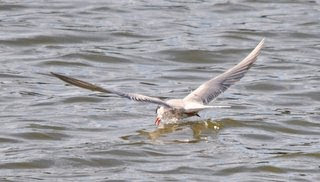Gannet. Gary Jones.
If I can be excused for using some repetitive words on the blog, the excellent in flight Gannet photographed at Bass Rock by Gary Jones has absolutely nothing connected to the post but is a brilliant piece of work for which I thank Gary very much.
Searching through old records is an excellent pastime and one which is guaranteed to turn up something of interest. Arriving at the LDBWS Annual Report for 1994 I was delighted to come across a record of mine which from the moment I set eyes on the bird was going to be a 'first' for the area. As I recall I had hardly turned off the car motor on my arrival at Teal Bay on 19 November 1994 when I saw a Charadrius on the groyne, instantly it wasn't either Ringed, or - perhaps even less likely - Little Ringed Plover not least of all because it didn't even look like one but it also had black legs....KENTISH PLOVER....heck!!
OK, now these were the days before the mobile and I knew someone who'd be really interested to hear about this bird and off I shot to Heysham with the news. Now I'm not exactly sure about the finer details on my arrival at Heysham but am almost certain 'egg and bacon' comes into the story here....'a Charadrius with black legs at Teal Bay and all other characteristics to match has to be a Kentish Plover hasn't it'....I said, upon which I was followed the full length of Morecambe promenade and back to Teal Bay only to find some activity by windsurfers hadn't helped to keep the bird on the groyne and it had made its departure much sooner than either of us would have wished for.
Now the story about this little wader becomes an even more interesting one in that - what had to be - the very same bird was seen a 'couple' of hours later at Rossall Point, Fleetwood where this individual had returned to winter for its fourth consecutive year and was found with 50 Ringed Plovers in the high tide roost near the old coastguard station where it was subsequently often found by an admiring number of birders until at least 4 February 1995. This same individual eventually went on to complete its sixth winter in this area of Fleetwood but was noted to wander a little more this time on occasions and made visits to Knott End, it was last seen on 21 March 1997 and never returned to winter here again.











_-1.jpg)




















.jpg)
_.jpg)









